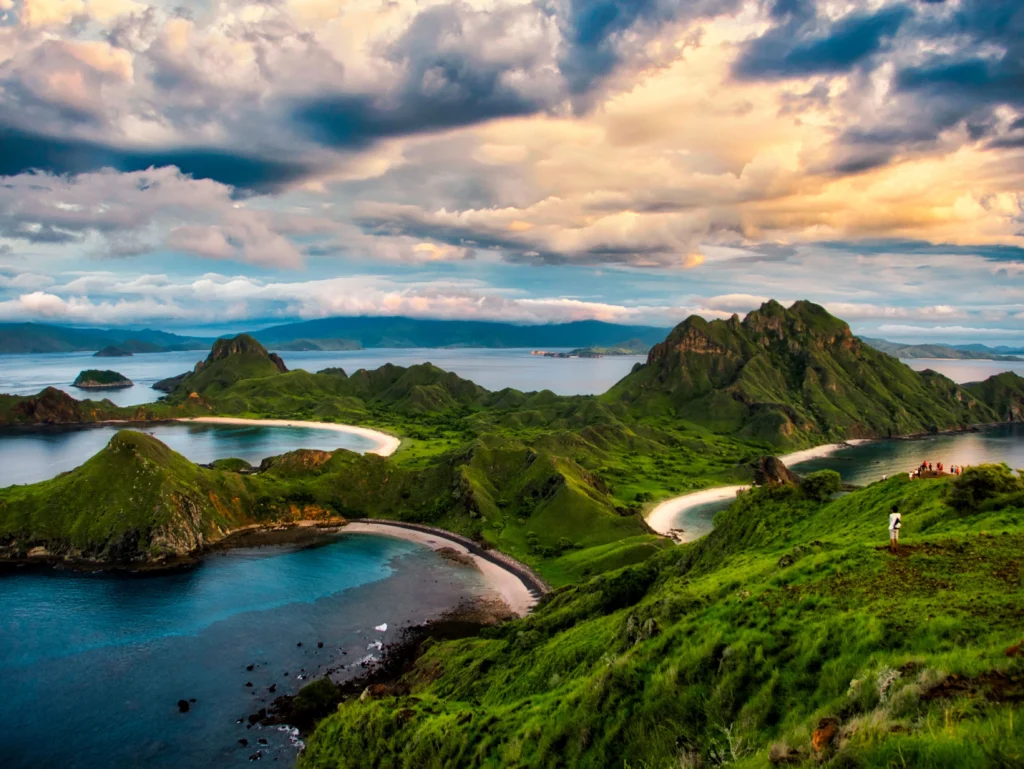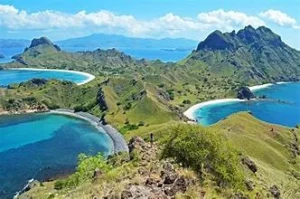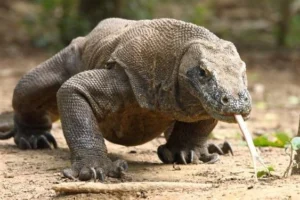The Komodo National Park in Indonesia is one of the most astonishing natural tourist destinations, offering an immersive experience with the unique beauty of its flora and fauna. In this article, we will explore the charm of Komodo National Park, starting by examining the captivating diversity of its flora and fauna, then delving into various activities enjoyed by visitors. Let’s celebrate the natural richness and conservation efforts that make this national park an exceptional place.
Flora of Komodo National Park
-
Bougainvillea: A magnificent and colorful flower, bougainvillea is a distinctive element of the national park with its enchanting beauty throughout the year.
-
Fragrant Pandanus: A plant with a distinct fragrance, fragrant pandanus adds a touch of freshness to the air, being one of the plants often used by the local population.
-
Rafflesia: The world’s largest flower, rafflesia, is a major attraction in Komodo National Park. When it blooms, its rare beauty captures the attention of every visitor.
-
Lontar Palm: An endemic tree, the lontar palm significantly contributes to the diversity of the tropical forest with its robust leaves and fibers used for traditional purposes.
-
Arenga Palm: The Arenga palm tree, with its sturdy trunk and broad leaves, adorns the forests of the national park, creating a powerful and beautiful landscape.
-
Komodo National Park Edelweiss: The local edelweiss flower adds a touch of beauty to the highlands, being one of the plants resilient to harsh environmental conditions.
-
Forest Mushrooms: The presence of unique forest mushrooms is an integral part of the Komodo National Park ecosystem, adding to the richness of the region’s microorganisms.
Fauna of Komodo National Park
source: pinterest.com
-
Komodo Dragon: This giant reptile is the symbol of the national park, with impressive size and global rarity.
-
Eagle: The eagle, with its broad wings and graceful flight, soars through the national park sky, adding beauty to the landscape with its precision.
-
Yellow-crested Cockatoo: A joyful and colorful bird, it is part of the fauna diversity of Komodo National Park, often seen gathering in trees.
-
Seagull: Coastal areas of the national park are inhabited by seagulls, creating a lively atmosphere around the beaches and offering a unique experience to visitors.
-
Saltwater Crocodile: Navigating the waters around the national park, the saltwater crocodile is one of the few crocodile species living in a marine environment.
-
Dolphins: The presence of dolphins in the surrounding waters of the national park adds to the appeal of diving activities, providing an unforgettable experience.
-
Wild Boar: Wild boars living in the forests of the national park are an important part of the ecosystem, offering a glimpse into wildlife in the region.
Komodo
source: pinterest.com
The Komodo, or Varanus komodoensis, is one of the giant reptiles that captivates visitors to Komodo National Park in Indonesia. With its imposing size and a reputation as a top predator, the Komodo presents various interesting aspects, from its diet to its habitat and species.
Komodo’s Diet
The Komodo is known as an aggressive and efficient carnivore. Its main source of food is meat, and it is not very selective. In its natural habitat, the Komodo hunts various animals, including deer, wild boars, and small lizards. It uses its sharp teeth and powerful claws to tear the flesh of its prey. Although capable of hunting larger animals, the Komodo often prefers smaller prey to facilitate the hunting process. However, interestingly, the Komodo also exhibits cannibalistic tendencies. Adult Komodos may sometimes hunt young Komodos, creating a unique dynamic within their population.
Komodo’s Habitat
The natural habitat of the Komodo involves arid and dry islands in the Nusa Tenggara Timur region, including Komodo, Rinca, Flores, Gili Motang, and Gili Dasami. These islands feature diverse landscapes, including grasslands, tropical forests, and coastal areas. The Komodo is more often found in drier habitats, where it can easily track and hunt its prey. The Komodo also has the ability to swim, and sometimes it navigates from one island to another. This expands its habitat range and allows access to different resources.
Komodo Species
Although all Komodos belong to the same species, there are differences between Komodo populations on different islands. Some genetic studies suggest there is a small amount of genetic variation between Komodo populations on different islands. Currently, three subspecies are recognized:
-
Varanus komodoensis komodoensis: Found on Komodo Island.
-
Varanus komodoensis floresensis: Found on Flores Island.
-
Varanus komodoensis barabati: Found on Rinca Island.
While these differences may not be very pronounced physically, they describe the adaptations of the Komodo to the local environment of the islands where they live.
Activities to Do in Komodo National Park
Komodo National Park is not limited to observing flora and fauna. Visitors can choose from various adventure activities, from hiking through dense green forests to snorkeling in waters rich in marine life. Camping under the starry sky, bird watching for rare birds, and photography tours to capture the wonders of nature can all be enjoyed in this national park. Additionally, conservation and education activities are also available for those who want to deepen their understanding of the unique flora and fauna conservation efforts of Komodo National Park.
Access to Komodo National Park
-
Air access: Komodo Airport (Labuan Bajo): The first step to reach Komodo National Park is through Komodo Airport located in Labuan Bajo, Flores. This airport is the main gateway to access the national park. Several domestic airlines offer flights to Komodo Airport, making it easily accessible from several major cities in Indonesia, such as Jakarta, Denpasar, and Surabaya.
-
Maritime access: Labuan Bajo Port: For those who prefer sea travel, ferries and fast boats are available from major ports around Nusa Tenggara Timur. Labuan Bajo Port is the center of these maritime activities and offers convenient travel options to reach the national park.
-
Land access: Labuan Bajo to Komodo National Park Route: Once in Labuan Bajo, visitors can continue their journey to Komodo National Park by land. Vehicles such as taxis or rental cars can be used to reach the port and then continue the journey to Komodo or Rinca Island.
-
Entrance tickets and permits: Purchase of entry tickets: Every visitor wishing to enter Komodo National Park must purchase an entry ticket. These tickets can be bought at the main entrance gate, usually located on Komodo or Rinca Island. Rates vary for domestic and international tourists, as well as for children and adults. Authorization and tour guide: In addition to entry tickets, visitors must also use the services of a local guide or tour guide during their stay in the national park. This is to ensure safety and provide accurate information about the flora, fauna, and conservation rules of Komodo National Park.
-
Conservation and environmental ethics: Importance of respecting conservation rules: Visitors are required to respect the conservation rules in place at Komodo National Park. This includes not feeding or disturbing the park’s animals and maintaining cleanliness and environmental preservation.
Conclusion
With its astonishing floristic and faunal richness, Komodo National Park offers an unforgettable experience to visitors. From the beauty of the rafflesia flower to the robustness of the Komodo, each element of nature is an integral part of a unique ecosystem. By participating in various adventure activities, visitors can feel the beauty of Indonesian nature and support conservation efforts to preserve Komodo National Park as a precious natural heritage.
Embark on your journey to Komodo Island with Hi Bali, ready to help and accompany you to enjoy the beauty and richness of the flora and fauna of Komodo National Park in Indonesia.







